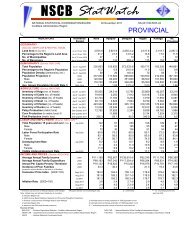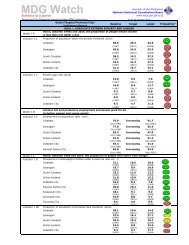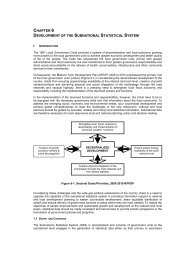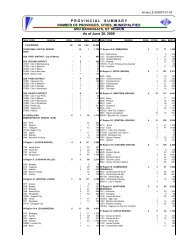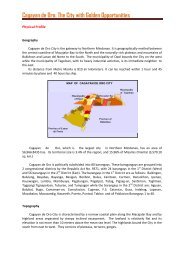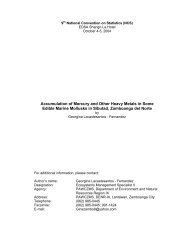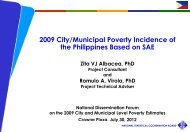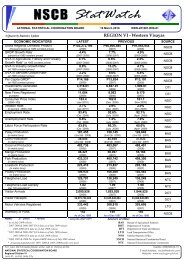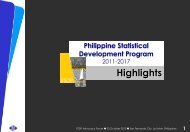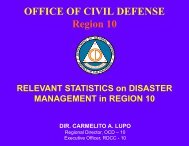Academic Programs in Statistics in the Philippines - NSCB
Academic Programs in Statistics in the Philippines - NSCB
Academic Programs in Statistics in the Philippines - NSCB
You also want an ePaper? Increase the reach of your titles
YUMPU automatically turns print PDFs into web optimized ePapers that Google loves.
MAS program was formalized <strong>in</strong> 1979 as an academic program of PUP through amemorandum of agreement between <strong>the</strong> Philipp<strong>in</strong>e National <strong>Statistics</strong>Office(PNSO) and PUP. This was done through <strong>the</strong> efforts of Dr. Tito A. Mijares,<strong>the</strong>n <strong>the</strong> Executive Director of PNSO, who realized <strong>the</strong> need for those engaged <strong>in</strong><strong>the</strong> practice of statistics to undergo fur<strong>the</strong>r studies <strong>in</strong> statistical <strong>the</strong>ory, methodsand data analysis. The program was fur<strong>the</strong>r enhanced <strong>in</strong> 2000(Africa andIgnacio, 2001).III.FacultyProfil<strong>in</strong>g faculty of schools that offer academic programs <strong>in</strong> statistics yields<strong>the</strong> conclusion that <strong>the</strong>re is still a dearth <strong>in</strong> <strong>the</strong> teach<strong>in</strong>g workforce. The CHEDstudy reported that, <strong>in</strong> 1999, all <strong>the</strong> schools <strong>in</strong> <strong>the</strong> survey had, on <strong>the</strong> average,thirteen (13) full-time faculty and three(3) part-time faculty. Fur<strong>the</strong>rmore, <strong>the</strong>faculty of eleven(11) schools that offer statistics programs had a workforce oftwenty one(21) faculty with Ph.D. <strong>in</strong> <strong>Statistics</strong>, forty five(45) with Masteraldegrees <strong>in</strong> <strong>Statistics</strong>, and twenty n<strong>in</strong>e(29) with Bachelor’s degrees <strong>in</strong> <strong>Statistics</strong>.An ongo<strong>in</strong>g study on scientific and technological human resources <strong>in</strong> <strong>the</strong>Philipp<strong>in</strong>e education sector be<strong>in</strong>g conducted by <strong>the</strong> U.P. Statistical CenterResearch Foundation, Inc., <strong>the</strong> research foundation of <strong>the</strong> U.P. School of<strong>Statistics</strong>, reported that <strong>the</strong> estimated number of faculty with <strong>Statistics</strong> degrees issignificantly fewer than those with Ma<strong>the</strong>matics degrees. Table 2 below presents<strong>the</strong> statistics.Table 2. Number of Faculty <strong>in</strong> <strong>the</strong> Basic and Ma<strong>the</strong>matical SciencesBy Degree, Philipp<strong>in</strong>es, June 2001*DegreeNumber of FacultyM. Actuarial Science 1M.S./M.A. Applied Ma<strong>the</strong>matics/Ma<strong>the</strong>matics 507D.S./Ph.D. Applied Ma<strong>the</strong>matics/Ma<strong>the</strong>matics/Ma<strong>the</strong>matical Science 81M./M.S. <strong>Statistics</strong>/Applied <strong>Statistics</strong> 64Ph.D. <strong>Statistics</strong>/<strong>Statistics</strong> and Research 17M.A./M.S. General Science/M. Applied Science 9M./M.S. Science(specialization not specified) 30M. Science o<strong>the</strong>r sciences) 3Ph.D. ( o<strong>the</strong>r sciences) 1Ph.D. <strong>in</strong> Science (specialization not specified) 3*Source: Prelim<strong>in</strong>ary Report of Projection of Scientific and TechnologicalHuman Resources <strong>in</strong> <strong>the</strong> Philipp<strong>in</strong>e Education Sector, a U.P. StatisticalCenter Research Foundation, Inc. Project for CHEDA closer look at <strong>the</strong> profile of faculty of selected schools shows that,except for UPLB, majority of <strong>the</strong> faculty have masteral degree. The follow<strong>in</strong>gtable, Table 3, shows <strong>the</strong> distribution of faculty.



